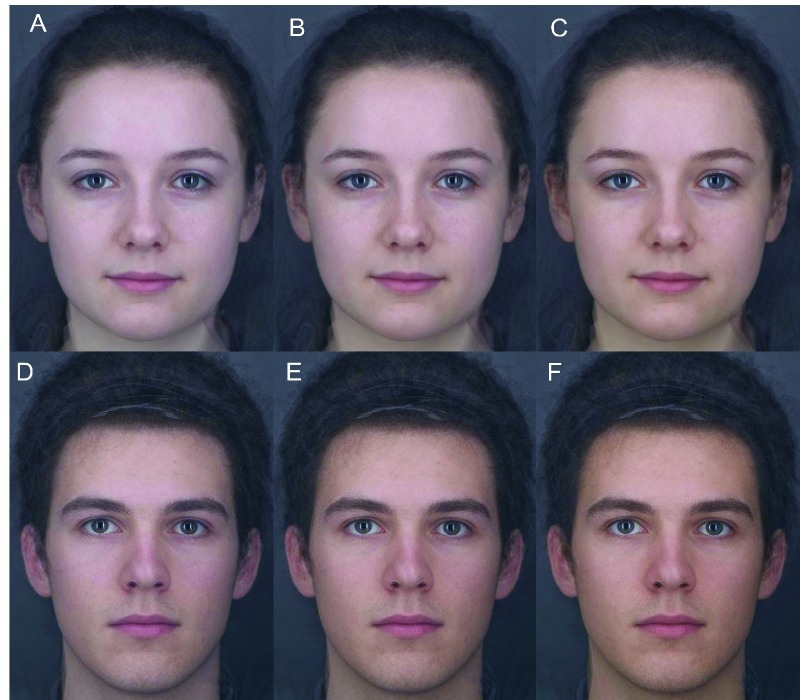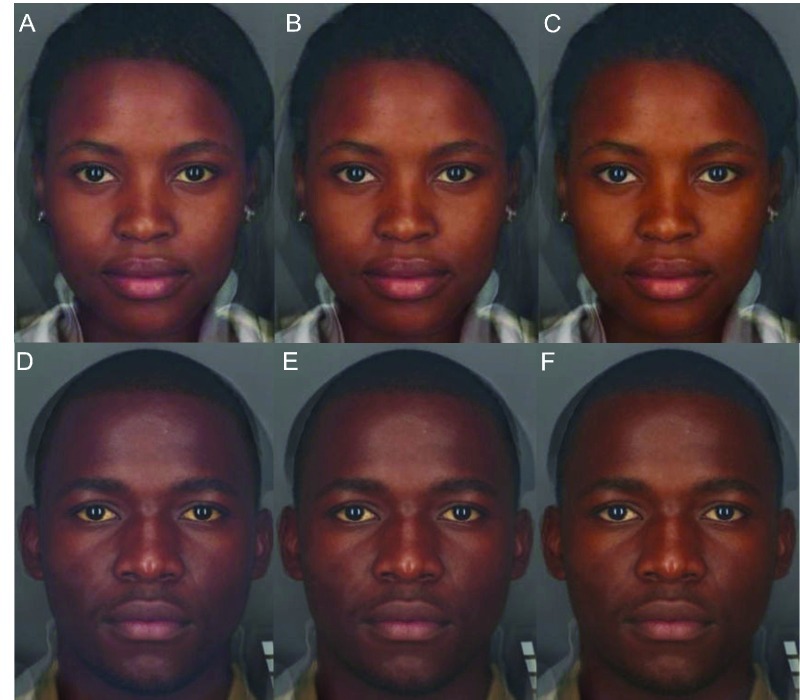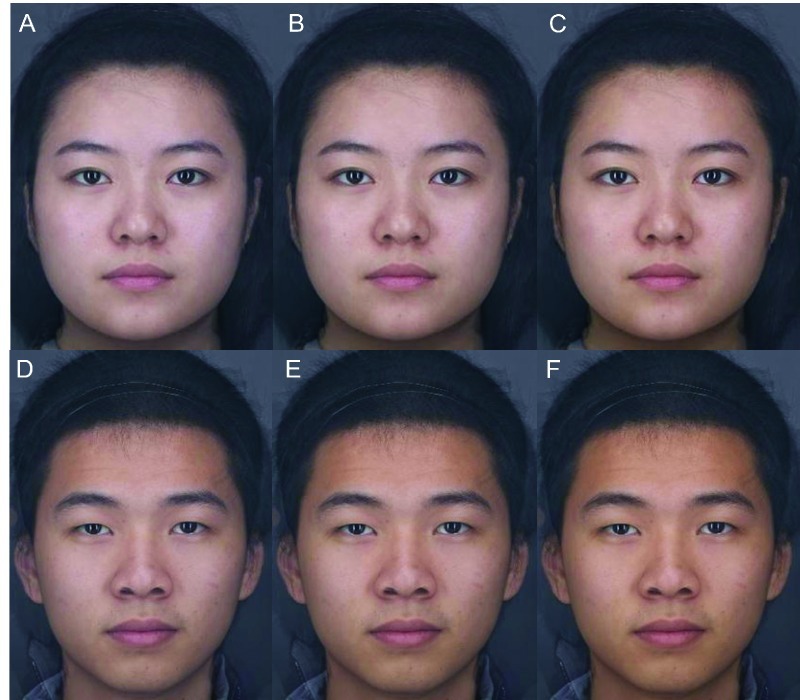Carotenoids, a class of more than 600 plant pigments, impart yellow-red coloration to fruits and vegetables. These pigments also color human skin1 and reflect the individual's diet; high consumers of fruit and vegetables have greater skin yellowness than do low consumers,2 and changes in diet quickly affect the level of carotenoids in the skin.3,4 Serum carotenoid levels are lowered during chronic infection5,6; hence skin carotenoid levels and skin color may serve as a perceptible cue of general health and diet quality.7 Carotenoid coloration has been shown to benefit appearance. White individuals who are able to manipulate the skin color of facial images consistently increase the yellowness to optimize the appearance of health.2
Projected effects of fruit and vegetable consumption on White facial appearance. Each image is a blend of four faces of the same sex, thereby removing cues to individual identity. The central column (b, e) reflects the individual's starting skin color under calibrated conditions. The left images (a, d) simulate the effect of a 6.5 portion per day decrease in fruit and vegetable consumption. The right column (c, f) simulates the effect of increasing fruit and vegetable consumption by 6.5 portions. These simulations are based on the association of spectrophotometrically measured skin color and fruit and vegetable consumption in a mixed group of White and Asian ethnicity.2,4
Projected effects of fruit and vegetable consumption on Asian facial appearance. Images manufactured in similar way to that described previously.
Projected effects of fruit and vegetable consumption on African facial appearance. Images manufactured in similar way to that described previously.
Individuals may be motivated to improve their diet if they are presented with images such as those in this article (see our Commentary in this issue as well), which illustrate the potential effect that a healthy diet can have on appearance. Such an approach could be suitable for reaching a wide audience; therefore, it is important to consider whether the change in skin coloration is seen as attractive across cultures. Empirical research suggests that this would be the case: African2 and Asian (R. D. W., unpublished data, April 2010) individuals share the preference with White individuals for raised skin yellowness in their own faces. This is illustrated in the facial images, which project the effect of increased or decreased fruit and vegetable consumption across different ethnicities.
Acknowledgments
This work was supported financially by the UK Economic and Social Research Council, Unilever Research, the British Academy, and the Wolfson Foundation.
The authors would like to thank Daniel Re, Lesley Ferrier, Pete Wilcox, Anne Perrett, Dengke Xiao, and David Roche.
References
- 1. Simon Alaluf, Ulrike Heinrich, Wilhelm Stahl, Hagen Tronnier, Shiela Wiseman, “Dietary Carotenoids Contribute to Normal Human Skin Color and UV Photosensitivity.” Journal of Nutrition 132 (2002): 399–403. [DOI] [PubMed]
- 2. Ian Stephen, Vinet Coetzee, David I. Perrett, “Carotenoid and Melanin Pigment Coloration Affect Perceived Human Health.” Evolution and Human Behavior: Official Journal of the Human Behavior and Evolution Society 32 (2011): 216–27.
- 3. Maxim E. Darvin, Alexa Patzelt, Fanny Knorr, Ulrike Blume-Peytavi, Wolfram Sterry, Juergen Lademann, “One-Year Study on the Variation of Carotenoid Antioxidant Substances in Living Human Skin: Influence of Dietary Supplementation and Stress Factors.” Journal of Biomedical Optics 13 (2008): 044028. [DOI] [PubMed]
- 4. Ross David Whitehead, David I. Perrett, Gozde Ozakinci, “Appealing to Vanity: Does Seeing the Potential Appearance-Benefits of Fruit and Vegetable Consumption Motivate Dietary Change? Annals of Behavioral Medicine: A Publication of the Society of Behavioral Medicine 41 (2011): S214.
- 5. Stéphane Walrand, Marie-Chantal Farges, Olivier Dehaese, Nicolas Cardinault, Régine Minet-Quinard, Pascal Grolier, Corinne Bouteloup-Demange, Josep Ribalta, Brigitte M. Winklhofer-Roob, Edmond Rock, Marie-Paule Vasson, “In Vivo and In Vitro Evidences That Carotenoids Could Modulate the Neutrophil Respiratory Burst During Dietary Manipulation.” European Journal of Nutrition 44 (2005): 114–20. [DOI] [PubMed]
- 6. Henrik Friis, Exnevia Gomo, Pernille Kastel, Patricia Ndhlovu, Norman Nyazema, Henrik Krarup, Kim F. Michaelsen, “HIV and Other Predictors of Serum β-Carotene and Retinol in Pregnancy: A Cross-Sectional Study in Zimbabwe.” American Journal of Clinical Nutrition 73 (2001): 1058–65. [DOI] [PubMed]
- 7. Vinkler M, Albrecht T, “Carotenoid Maintenance Handicap and the Physiology of Carotenoid-Based Signalisation of Health.” Naturwissenschaften 97 (2010): 19–28. [DOI] [PubMed]





